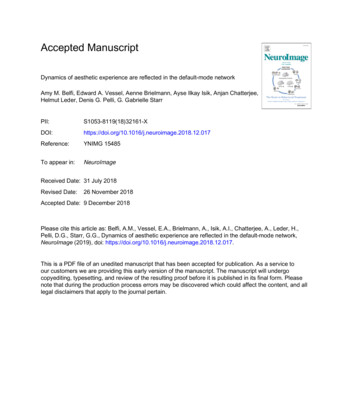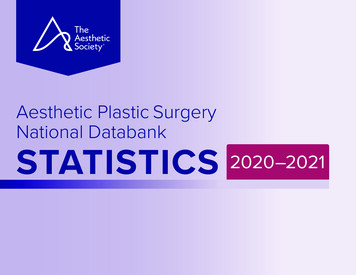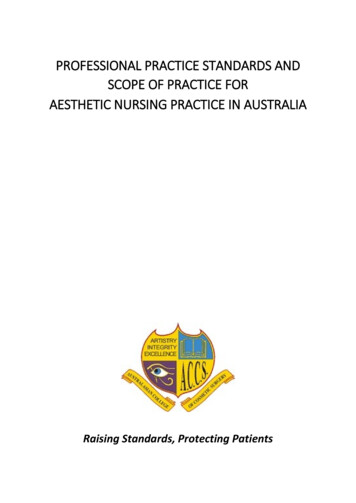
Transcription
Accepted ManuscriptDynamics of aesthetic experience are reflected in the default-mode networkAmy M. Belfi, Edward A. Vessel, Aenne Brielmann, Ayse Ilkay Isik, Anjan Chatterjee,Helmut Leder, Denis G. Pelli, G. Gabrielle 10.1016/j.neuroimage.2018.12.017Reference:YNIMG 15485To appear in:NeuroImageReceived Date: 31 July 2018Revised Date:26 November 2018Accepted Date: 9 December 2018Please cite this article as: Belfi, A.M., Vessel, E.A., Brielmann, A., Isik, A.I., Chatterjee, A., Leder, H.,Pelli, D.G., Starr, G.G., Dynamics of aesthetic experience are reflected in the default-mode network,NeuroImage (2019), doi: his is a PDF file of an unedited manuscript that has been accepted for publication. As a service toour customers we are providing this early version of the manuscript. The manuscript will undergocopyediting, typesetting, and review of the resulting proof before it is published in its final form. Pleasenote that during the production process errors may be discovered which could affect the content, and alllegal disclaimers that apply to the journal pertain.
ACCEPTED MANUSCRIPTDynamics of aesthetic experience1SCMANUAmy M. Belfia*Edward A. Vesselb*Aenne BrielmanncAyse Ilkay IsikbAnjan ChatterjeedHelmut LedereDenis G. PellicG. Gabrielle StarrfRIPTDynamics of aesthetic experience are reflected in the default-mode networka*TEDDepartment of Psychological Science, Missouri University of Science and Technology, Rolla,MObDepartment of Neuroscience, Max Planck Institute for Empirical Aesthetics, Frankfurt,GermanycDepartment of Psychology, New York University, New York, NYdDepartment of Neurology, University of Pennsylvania School of Medicine, Philadelphia, PAeDepartment of Basic Psychological Research and Research Methods, University of Vienna,Vienna, AustriafDepartment of English, Pomona College, Claremont, CAThese authors contributed equally to this workACCEPCorresponding authors:Amy M Belfi.Department of Psychological ScienceMissouri S&T135 H-SSRolla, MO 65409amybelfi@mst.eduEdward A. VesselMax Planck Institute for EmpiricalAestheticsGrüneburgweg 14, 60322 Frankfurt amMained.vessel@aesthetics.mpg.deConflict of interest statement: The authors declare no competing financial interests.Acknowledgements: We would like to acknowledge the following: Clay Curtis for suggestionson statistical analysis, Kat Markowski for help with fMRI data preprocessing, David Poeppel forhelp with project management, and Lauren Vale for help with squeezeball implementation.Funding was provided by the NYU Global Institute for Advanced Study.
ACCEPTED MANUSCRIPTDynamics of aesthetic experience2AbstractNeuroaesthetics is a rapidly developing interdisciplinary field of research that aims tounderstand the neural substrates of aesthetic experience: While understanding aestheticRIPTexperience has been an objective of philosophers for centuries, it has only more recently beenembraced by neuroscientists. Recent work in neuroaesthetics has revealed that aestheticexperience with static visual art engages visual, reward and default-mode networks. Very little isSCknown about the temporal dynamics of these networks during aesthetic appreciation. Previousbehavioral and brain imaging research suggests that critical aspects of aesthetic experience haveMANUslow dynamics, taking more than a few seconds, making them amenable to study with fMRI.Here, we identified key aspects of the dynamics of aesthetic experience while viewing art forvarious durations. In the first few seconds following image onset, activity in the DMN (and highlevel visual and reward regions) was greater for very pleasing images; in the DMN this activityTEDcounteracted a suppressive effect that grew longer and deeper with increasing image duration. Inaddition, for very pleasing art, the DMN response returned to baseline in a manner time-lockedto image offset. Conversely, for non-pleasing art, the timing of this return to baseline wasEPinconsistent. This differential response in the DMN may therefore reflect the internal dynamicsof the participant’s state: The participant disengages from art-related processing and returns toACCstimulus-independent thought. These dynamics suggest that the DMN tracks the internal state ofa participant during aesthetic experience.
ACCEPTED MANUSCRIPTDynamics of aesthetic experience3Neuroaesthetics is a rapidly developing interdisciplinary field of research that aims tounderstand the neural processes underlying aesthetic experiences (Chatterjee & Vartanian, 2014;Pearce et al., 2016). Several theories describe an aesthetic experience as a series of processingRIPTstages, beginning with low-level perceptual analysis and culminating in a judgment or action(Chatterjee, 2004; Leder & Nadal, 2014; Pelowski, Markey, Forster, Gerger, & Leder, 2017). Arecent investigation of the temporal evolution of aesthetic experience found that aestheticSCpleasure evoked by a visual image grows over a few seconds, is sustained, and decays slowly,over one hundred seconds after image offset (Brielmann & Pelli, 2017).MANUDespite the theoretical and psychophysical characterization of these temporal dynamics,most neuroimaging work has treated aesthetic experience as a static event. For example, viewersare typically asked to make a single binary judgment such as characterizing an artwork as‘beautiful’ or ‘not beautiful.’ Despite the lack of a temporally extended behavioral measurement,TEDthis work provides some hints as to the neural dynamics of aesthetic experience. Prior fMRI datasuggest two distinct neural systems underlying aesthetic experience: One, consisting primarily ofperceptual and reward-related regions, responds in a manner that is linearly related to aestheticEPappreciation, while a second, consisting of prefrontal and default mode network (DMN) regions,is only engaged by artwork deemed strongly aesthetically moving by the viewer (Vessel, Starr, &ACCRubin, 2012). MEG data suggest one set of brain regions is engaged during initial exposure to anartwork (250-750 ms post-onset), while a second set of regions, whose pattern is consistent withthe DMN, is active during a later time window (1000-1500 ms; Cela-Conde et al., 2013). Thistiming is consistent with the fMRI BOLD signal timecourse observed in anterior medialprefrontal cortex (aMPFC), a core node of the DMN, where an initial suppression was followedby a rise several seconds later only for those artworks found most aesthetically appealing
ACCEPTED MANUSCRIPTDynamics of aesthetic experience4(Vessel, Starr, & Rubin, 2013). Additionally, an fMRI study of facial attractiveness found thatreward regions were temporally dissociable during aesthetic preference judgments: The nucleusaccumbens was engaged earlier and the orbitofrontal cortex was engaged later (Kim, Adolphs,RIPTO’Doherty, & Shimojo, 2007). Similar work investigating the neural correlates of creativecognition have identified this as a two-step process, also involving engagement of the DMN (forreview, see Beaty, Benedek, Silvia, & Schacter, 2016). Overall, this work identifies at least threeSClarge-scale networks involved in aesthetic experience – perceptual, reward, and default-modenetworks – and indicates that these networks are differentially engaged during exposure toMANUartworks the viewer finds especially aesthetically appealing.One major unresolved issue is the potential effects of stimulus duration on the cognitiveand neural correlates of aesthetic experience. For example, prior work in museum settings hasidentified the average looking time as 28-38 s (Brieber, Nadal, Leder, & Rosenberg, 2014),TEDwhich is substantially longer than most artworks are presented in prior neuroaesthetics research.Recent work investigating aesthetic responses to music has identified that listeners can makeaccurate aesthetic judgments in as little as hundreds of milliseconds (Belfi et al., 2018). As recentEPattention has been dedicated to studying neural responses to extended, naturalistic stimuli,primarily in the auditory domain (Burunat, Alluri, Toiviainen, Numminen, & Brattico, 2014;ACCDesai, Choi, Lai, & Henderson, 2016; Huth, Heer, Griffiths, Theunissen, & Jack, 2016), wesought to investigate the neural correlates of aesthetic experience in response to both shorter andextended viewings of artworks. In addition to identifying differences in aesthetic experience toartworks of varying durations, this allows for identification of responses to stimulus onset versusstimulus offset. There has been evidence for multiple stages of processing during aestheticexperience, some of which may only occur after prolonged exposure to or removal of the visual
ACCEPTED MANUSCRIPTDynamics of aesthetic experience5stimulus (Cela-Conde et al., 2013; Jacobsen & Höfel, 2003). Yet, these differential responses tostimulus onset and offset versus stages of aesthetic experiences have not yet been characterizedneurally. Therefore, it is unknown which neural responses correspond to the initial and laterRIPTstages of aesthetic experience, versus those that correspond to stimulus onset/offset.An additional unresolved issue, when looking at more naturalistic viewing times, is theissue of extended behavioral responses to aesthetic experiences. In standard aestheticsSCexperiments, participants view an aesthetic object and are asked to make a discrete, summativerating about that object. For example, viewers often make a binary judgment such asMANUcharacterizing an artwork as ‘beautiful’ vs. ‘not beautiful’ (Cela-Conde et al., 2009, 2013;Flexas, Rossello, de Miguel, Nadal, & Munar, 2014; Kornysheva, Von Cramon, Jacobsen, &Schubotz, 2010; Müller, Höfel, Brattico, & Jacobsen, 2010; Munar et al., 2012). Morecommonly, aesthetic judgments are made on a discrete Likert-scale, where participants rate anTEDitem’s degree of beauty or aesthetic appeal (Bohrn, Altmann, Lubrich, Menninghaus, & Jacobs,2013; de Tommaso et al., 2008; Jacobs, Renken, & Cornelissen, 2012; Jacobsen, Schubotz,Höfel, & Cramon, 2006; Kawabata & Zeki, 2004; Mallon, Redies, & Hayn-Leichsenring, 2014).EPOne disadvantage of this approach is that a summary judgment after a stimulus has beenpresented gives no insight into experience during one’s engagement with the work of art, andACCsubstitutes a post-hoc measure for what is fundamentally a dynamic experience.Research in other fields has taken a moment-based, continuous approach to recordbehavioral responses dynamically during stimulus presentation. In fact, research from otherfields has indicated that a post-stimulus summary judgment may not accurately reflect themoment-by-moment experience during the stimulus (Do, Rupert, & Wolford, 2008; Kahneman,2000b). Various metrics of the continuous trace, such as the mean, peak value, maximum slope,
ACCEPTED MANUSCRIPTDynamics of aesthetic experience6or end value, have been used to predict an overall rating, with varying degrees of success (Rozin,Rozin, & Goldberg, 2004; Schafer, Zimmermann, & Sedlmeier, 2014). Overall, this researchindicates that overall and continuous measurements capture different aspects of an experience.RIPTGiven this disparity, the application of continuous methods to the field of neuroaesthetics isnecessary to understand the temporal dynamics of aesthetic experience.In the present work, we varied the duration of the stimulus presentation and continuouslySCmeasured behavioral and neural responses during a 14 second post-stimulus period. We aimed toidentify: 1) which brain networks respond differentially to aesthetic appreciation, 2) when thisMANUresponse occurs, and 3) which aspects of the response are tied to stimulus onset and offset. Wepredicted that 1) regions in the DMN would be suppressed during image presentation, 2) DMNsignal during highly-pleasing artworks would show a reduction or even reversal of this stimulusrelated suppression, and that 3) DMN activity would show a ‘lingering’ of increased activityTEDduring the post-stimulus period, similar to the behavioral evidence for sustained aestheticappreciation. Conversely, we predicted that reward-related regions and higher-level visualregions would be affected by aesthetic appreciation during stimulus exposure but that this wouldEPnot persist after image offset.Materials and MethodsACCParticipantsThirty participants were recruited at New York University and paid for theirparticipation. Five participants were excluded due to excessive motion (see below), leaving afinal group of 25 participants (8 men, 17 women; 24 right-handed; 27.56 6.49 years of age).The Institutional Review Board approved this study and all participants gave informed consent inaccordance with the New York University Committee on Activities Involving Human Subjects.
ACCEPTED MANUSCRIPTDynamics of aesthetic experience7Our sample size was determined by conducting a power analysis based on data from ourprevious work, which reported effect sizes in DMN regions of interest (ROIs) around η2 0.80(Vessel et al., 2012). Using G*Power software (Faul, Erdfelder, Lang, & Buchner, 2007), thisRIPTpower analysis indicated a sample of 20 participants would be sufficiently powerful (at a 1-βlevel of 0.95) to detect an effect this large. Thus, our sample size is more than adequate for themain objective of this study and should allow for sufficient power to detect our predicted effects.SCStimuliImages selected were chosen from those used in previous work (Vessel et al., 2012).MANUNinety images were selected from the Catalog of Art Museum Images Online database (CAMIO:http://www.oclc.org/camio). These images are high-quality photographs of paintings from avariety of cultural traditions (American, Asian, European) and time periods (15th century to thepresent). Commonly reproduced images were not included in order to minimize familiarity; in aTEDprevious study using more images (109 artworks; Vessel et al., 2012), very few participants (fourof sixteen), some of whom had extensive art history expertise, were able to identify specificartworks that had been seen previously, though a larger number (eleven) expressed vagueEPfamiliarity with “a few” images. Images were scaled so that the largest dimension did not exceed20 of visual angle and the area did not exceed 75% of a 20 box. Stimulus presentation wasACCcontrolled using the Psychophysics Toolbox in MATLAB (Brainard, 1997; Pelli, 1997). SeeFigure 1A for examples of the stimuli used.ProcedurePrior to the experiment, participants completed a brief ( 10 minute) training sessionusing images not presented in the experiment to familiarize themselves with the task andresponse modalities. This training session was identical to the experimental procedures, such that
ACCEPTED MANUSCRIPTDynamics of aesthetic experience8participants were not given visual feedback when using the squeezeball. Before beginning theexperiment, participants were debriefed to ensure they were comfortable using the squeezeball asa response modality.RIPTDuring the fMRI experiment, participants viewed the 90 stimuli for one of threedurations: 1, 5, or 15 s. In order to capture participants’ initial response to each artwork, andsince aesthetic appreciation may change based on prior exposure (Cutting, 2003; Park, Shimojo,SC& Shimojo, 2010), each stimulus was presented only once over the course of the experiment.Therefore, participants saw 30 stimuli per duration. Image presentation was counterbalancedMANUacross participants, across durations, such that each image appeared a roughly equal number oftimes in each duration.Each trial began with a 1 s blinking fixation cross, followed by an image of an artwork.At the onset of the image, participants began continuously rating the pleasure they felt from theTEDstimulus (Figure 1A). Exact instructions to the participants were as follows: “When the imageappears on the screen, begin rating the pleasure you experience from the image” (full instructionscan be found in the Supplementary Materials). These continuous measurements were recordedEPusing an fMRI-compatible squeeze-ball and sampled at a rate of 10Hz. The squeeze-ball wasused to provide haptic feedback, so participants were aware of their rating without the need forACCvisual feedback (Nielsen, 1987). Participants were not aware of the duration of the stimulusprior to stimulus presentation. Following stimulus presentation, the screen remained blank for a14 s ‘post-stimulus’ rating period during which the participants continued to rate the pleasurethey were experiencing from having seen the artwork. After this post-stimulus rating period, avisual slider bar appeared on the screen and participants used a trackball in their opposite hand tomake a single rating of their ‘overall’ aesthetic appreciation of the image (4 s max response
ACCEPTED MANUSCRIPTDynamics of aesthetic experience9window). The instructions given to the participant stated: “Please rate, overall, how much thisimage ‘moved’ you. That is, how powerful, pleasing, or profound did you find the image.” SeeTEDMANUSCRIPTFigure 1B for a visual depiction of the trial structure.ACCEPFigure 1. Stimuli and trial structure. A. Examples of stimuli. B. Depiction of trial structure.Trials consisted of a 1 s fixation cross, followed by stimulus presentation for either 1, 5, or 15 s.At stimulus onset, participants began continuously rating their pleasure using an fMRIcompatible squeezeball. After stimulus offset, participants continued rating their pleasure duringa 14 s post-stimulus period. Following this post-stimulus period, participants had 4 s to make anoverall rating of the stimulus between low (L) and high (H) using a track ball held in the oppositehand.fMRI Scanning ProceduresAll fMRI scans took place at the NYU Center for Brain Imaging (CBI) using a 3TSiemens Allegra scanner with a Nova Medical head coil (NM011 head transmit coil). Stimuliwere presented using back-projection onto a screen mounted in the scanner and viewed through amirror on the head coil.
ACCEPTED MANUSCRIPTDynamics of aesthetic experience10The 90 artworks were divided into five runs and presented in an event-related design,with each run containing 6 trials of each duration. Timing of stimulus onset, ordering of 1, 5, and15 s trials, and inter-trial-intervals (mean ITI 6.76 s, range 2–20 s) were calculated using theRIPTOptSeq2 Toolbox (https://surfer.nmr.mgh.harvard.edu/optseq). Whole-brain BOLD signal wasmeasured from thirty-four 3 mm slices using a custom multi-echo (ME) echo-planar imaging(EPI) sequence (2 s TR, 80x64 3mm voxels, right-to-left phase encoding, FA 75 ). The ME EPISCsequence and a tilted slice prescription (15-20 tilt relative to the AC-PC line) were used tominimize dropout near the orbital sinuses. We collected a custom calibration scan to aid in MEMANUreconstruction, unwarping and alignment. Prior to the experimental runs, participants completeda 6-minute eyes-open rest scan. Following the functional scans, participants completed a highresolution (1 mm3) anatomical scan (T1 MPRage).Experimental Design and Statistical AnalysisTEDBehavioral data preprocessing. Continuous rating. The continuous rating dataunderwent a series of preprocessing steps prior to analysis. Due to the mechanics of thesqueezeball used to acquire the continuous data, a high-frequency ‘spike’ often accompanied theEPonset of each squeeze. To remove these artifacts and other high-frequency noise, a low-pass filter(cutoff frequency 0.25 Hz) was applied to the continuous rating data. Each run was thenACCnormalized by scaling the continuous rating data based on the average of two ‘maximum’squeezes provided by the participant prior to the start of each run. Participants were instructed tomake these maximum squeezes correspond to their maximum rating, not the hardest they couldpossibly squeeze. They were instructed to pick a level that could be sustained throughout thecourse of the experiment. All continuous data were scaled in this way for each run for eachparticipant, so that all continuous data for all participants was between 0 and 1.
ACCEPTED MANUSCRIPTDynamics of aesthetic experience11Overall rating. Each overall rating was a single value ranging between 0 and 1. Trialswere designated as ‘high,’ ‘medium,’ and ‘low’ aesthetic appreciation based on the value of theoverall rating given at the end of each trial. This binning into ‘high,’ ‘medium,’ and ‘low’ wasRIPTdone separately for each individual participant, not across all trials. Overall, participants tendedto use the entire range of the scale when making their responses (see Figure S2 for an illustrationof the range of participants’ ratings). Within each duration level (1, 5, 15 s), trials were dividedSCinto thirds, and the top third was designated as being high, the middle third as medium, and thebottom third as low. This post-hoc trial categorization resulted in nine total trial types: ThreeMANUdurations (1, 5, and 15 s) and three rating-levels (low, medium, and high), with ten trials in eachof the nine types. These trial types were used for analysis of both the behavioral and fMRI data.Behavioral data analysis. Continuous pleasure ratings are well fit by a simple modeladapted from previous studies (Brielmann & Pelli, 2017; Brielmann, Vale, & Pelli, 2017). ToTEDassess how pleasure amplitude, as identified by this model, changes with rating-level andstimulus duration, we conducted a 3x3 repeated measures ANOVA.fMRI preprocessing. ME EPI images were reconstructed using a custom algorithmEPdesigned by the NYU Center for Brain Imaging to minimize dropout and distortion, and weretested for data quality (e.g. spikes, changes in signal-to-noise) using custom scripts. The scansACCwere then preprocessed using the FMRIB Software Library (FSL; Oxford, UK) to correct formotion, align data across scans and apply a high-pass filter (0.01 Hz cutoff). High resolutionanatomical scans were segmented using FreeSurfer (http://surfer.nmr.mgh.harvard.edu).A measure of framewise movement displacement (fmd) was calculated from theestimated translational movements (x, y z) as:
ACCEPTED MANUSCRIPTDynamics of aesthetic experience12This measure is similar to the framewise displacement (Power, Barnes, Snyder, Schlaggar, &Petersen, 2012) but simpler to compute. Inspection of the maximum fmd for each participantrevealed four clear outliers (see Figure S1 in Supplementary Materials). Data from theseRIPTparticipants was not used for subsequent processing. Data from one additional participant wasalso removed; this participant moved after the initial localizer scan, bringing a large portion oftheir brain out of the circle of homogenous signal.SCROI selection and analysis. Three network ROIs were selected based on our a priorihypotheses regarding visual, reward, and DMN networks. Additionally, the frontoparietal controlMANUnetwork (FP), an important network for goal-directed cognition (Spreng, Stevens, Chamberlain,Gilmore, & Schacter, 2010), was analyzed for comparison (included in the SupplementaryMaterials). We selected ROIs in one of two ways. For the DMN, visual and FP network ROIs,we used the rest scan to functionally localize these networks in individual participantss. AfterTEDpreprocessing (motion correction, high-pass filtering at 0.005 Hz, spatial smoothing with 6mmFWHM Gaussian filter), independent component analysis (ICA) was performed on individualparticipants’ scans using MELODIC (FSL). MELODIC determines the appropriate size of theEPlower-dimensional space using the Laplace approximation to the Bayesian evidence of the modelorder (Beckmann, Noble, & Smith, 2001; Minka, 2000). This process resulted in an average ofACC24 spatial components (SD 9.5) for each participant. These ICA components were then movedinto MNI standard space and compared to a set of pre-defined network maps (Smith et al., 2009)using Pearson correlation. The component with the highest correlation to the Smith et al. (2009)DMN map was then visually inspected to ensure that its spatial distribution appeared similar tothe canonical DMN. For six participants, the DMN was split between two ICA components,which were combined to form a single component. The final DMN ROI for each participant was
ACCEPTED MANUSCRIPTDynamics of aesthetic experience13then defined as the voxels from this component that also belonged to gray matter (as defined bythe FreeSurfer gray matter segmentation).After transformation of these volumetric DMN maps to cortical surface space, a set ofRIPTfive subregions (anterior medial prefrontal cortex, aMPFC; dorsal medial prefrontal cortex,dMPFC; ventral medial prefrontal cortex, vMPFC; posterior cingulate cortex, PCC; inferiorparietal lobule, IPL) were identified in each hemisphere by masking the DMN map with a set ofSC"master" ROIs delineated on the Freesurfer fsaverage brain. These master ROIs, which eachcovered a contiguous region of cortex larger than the corresponding DMN subregion in any oneMANUparticipant, were drawn from the distribution of locations of these subregions observed in anindependent sample of 16 participants. This method was used in order to identify previouslycharacterized, spatially specific nodes of the DMN from each individual’s own functionalconnectivity in a manner that required minimal manual intervention. For the higher-level visualTEDnetwork, the component with the highest correlation to the Smith et al. (2009) “lateral visual”network was used, and the ROI was created in the same manner as the DMN. More specifically,we selected the “lateral visual” network since the inferior temporal sulcus (ITS; MNI coordinatesEP-49 -61 -2) activation reported in Vessel et al. (2012) falls within this network mask. For the FPnetwork, the components with highest correlation to Smith et al. (2009) “left frontoparietal” andACC“right frontoparietal” networks were identified. Eleven participants had a single bilateralcomponent, twelve had two lateralized components that were combined, and two had noacceptable match, leaving 23 participants for FP. Basal ganglia ROIs were defined anatomicallybased on the FreeSurfer “aparc” automatic segmentation. The caudate, putamen, pallidum, andnucleus accumbens were individually identified (bilaterally) and then combined to form thewhole basal ganglia ROI.
ACCEPTED MANUSCRIPTDynamics of aesthetic experience14General linear modeling was implemented using custom software written in MATLAB(MathWorks; Natick, MA, USA). Following extraction of an average timeseries from each ROI,residual signal variation due to head motion was removed by projecting out the framewiseRIPTdisplacement vector and its absolute value. Since the post-hoc trial sorting (by overall rating)resulted in an unequal number of trials in each condition per scan, the timecourses from all fivescans were z-scored and concatenated. This ROI timecourse was then modeled using a set ofSCfinite impulse response (FIR) functions time-locked to stimulus onset, one for each of the nineconditions (3 presentation durations x 3 rating groups). Each FIR included image presentation,MANUthe post-stimulus rating period, the overall-response period and 8 trailing timepoints. Theresulting parameter estimates were then averaged across participants for each time bin, resultingin estimates of fMRI signal change across the entire trial for each trial type, as well as anestimate of error at each timepoint (standard error of the mean; SEM).TEDThe high-, medium-, and low-rated trial conditions were compared using repeatedmeasures ANOVA for each ROI at each presentation duration (i.e., 1, 5, 15 s). These ANOVAswere conducted with time (from image onset until end of post-stimulus period) and conditionEP(high, medium, and low) as within-subjects factors (e.g., Shulman et al., 1999). As our goal is toidentify at which time points high trials differ from low trials, we sought to identify any time byACCcondition interactions. In this way, we chose to treat the low-rated trials as a “control” condition,as opposed to using a more standard “control” of, say, scrambled visual images. Importantly,including modified images (such as scrambled images) would interfere with the content of thestimuli (Fairhall & Ishai, 2008) which would likely have large effects on the aesthetic appeal ofthe images. This would then introduce a confound into the experiment, as it is likely thatscrambled images would be more likely to fall within the “low-rated” group. Instead, considering
ACCEPTED MANUSCRIPTDynamics of aesthetic experience15the low-rated trials themselves as a neutral “control” preserves the same content across the threecategories, as all low-, medium-, and high-rated images are still intact artworks. All interactionsare reported and include measures of effect size (ηp2). Any significant interactions were followedRIPTup by tests of simple main effects for pairwise comparisons; all were corrected for multipleinclude measures of effect size (Cohen’s d).ResultsContinuous pleasure ratings well fit by a prior modelSCcomparisons using Bonferroni correction (all p-values reported are corrected p-values) andMANUContinuous pleasure ratings were well fit by a simple model adapted from a previousstudy using a different manual response (finger spread on the surface of an iPad, eqs. 1-4 inBrielmann & Pelli, 2017). The model supposes a stable initial response level rinitial. Afterstimulus onset, pleasure asymptotically approaches the steady-state rsteady as a decayingTEDexponential with time constant τshort. After stimulus offset, pleasure asymptotically approachesthe final response level rfinal as a function of two decaying exponentials. The first begins shortlyafter stimulus onset (τshort after onset) and has the same time constant as the initial approach τshort.EPThe second is added to the first and begins at stimulus offset; it has the time constant τlong.The model has 5 free parameters: rinitial, r
T D ACCEPTED MANUSCRIPT Dynamics of aesthetic experience 1 Dynamics of aesthetic experience are reflected in the default-mode network Amy M. Belfi a* Edward A. Vessel b* Aenne Brielmann c Ayse Ilkay Isik b Anjan Chatterjee d Helmut Leder e Denis G. Pelli c G. Gabrielle Starr f aDepartment of Psychological Science, Missouri University of Science and Technology, Rolla,










